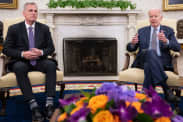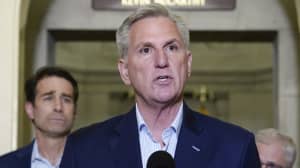“ Do lawmakers slight kids because they don’t have political action committees? ”
During the House debt ceiling debate, several members of Congress invoked the “next generation” as a newly discovered interest and reason for addressing the federal budget deficit.
While children’s advocates appreciate the fresh interest in children and agree that the deficit is an issue of importance to the next generation, it is nonsensical to argue that it is in the best interests of children for the House of Representatives to disproportionately subject them to significant long-term cuts. Unfortunately, that is what debt ceiling bill H.R. 2811 does.
Time and again, when Congress chooses to cut programs or funding, children are the primary target.
You can go back to 2018, when the Trump administration singled out the Children’s Health Insurance Program — which serves roughly 7 million children — to achieve nearly half of all the cuts in its proposed rescission or “clawback” package. Or back to 2009, when the Senate recommended a $100 billion reduction in the American Recovery and Reinvestment Act (the Great Recession’s stimulus package) — close to half of which came from programs that specifically help children, such as Head Start, school construction, education for disadvantaged children, and prevention programs.
Do lawmakers slight kids because they don’t vote? Because they don’t have political action committees? Because they’ve never demonstrated the ability to derail a re-election campaign?
Whatever the reasons, the current House leadership has chosen to deliberately exempt certain programs and populations — Social Security and Medicare, seniors and Strykers — while laying the burden squarely on children. In addition to protecting U.S. defense spending, which already outstrips spending by the next 10 nations combined, House leaders also have pledged to protect tax breaks for the wealthy.
So what’s left to cut? Start with discretionary spending, which funds the bulk of children’s programs. H.R. 2811 would cut discretionary spending by $130 billion immediately and other spending by an additional $3+ trillion over the next 10 years, according to the Congressional Budget Office.
New restrictions on how the states provide employment services and assistance under the Temporary Assistance for Needy Families program (TANF) could stop aid to more than 1 million children, according to the Center on Budget and Policy Priorities (CBPP), and significantly increase deep child poverty.
H.R. 2811 would slash funding to education, Head Start, child care, child health, child nutrition, child and family homelessness, and child-abuse prevention by an additional 22% or more. For good measure, the bill would specifically eliminate college debt relief and investments in the environment — both issues of importance to younger voters. The Congressional Budget Office projects that the House bill could also force the elimination of many children’s programs.
As a nation, the U.S. historically has underinvested in our children to a greater or lesser extent. During the Trump administration, the share of federal spending on children dropped by 24% — from 9.89% of the federal budget to 7.55%. (For the record, children account for roughly a quarter of the U.S. population). Emergency funding under the American Rescue Plan Act for items such as the Child Tax Credit and other pandemic outlays propelled this share to a historic high of 11.98%. Many of these provisions have since expired, and the proposed cuts suggest that lawmakers are racing to claw back whatever was spent on children.
In fact, they should be spending more money. Numerous studies have shown that investing in children delivers enormous returns to both children and the national economy. For instance, an extensive analysis by Harvard economists Nathaniel Hendren and Ben Spring-Keyser found that direct investments in the health and education of low-income children historically have yielded the highest returns, and, in fact, pay for themselves.
First Focus Campaign for Children recently released its 2023 Agenda for America’s Children, which outlines the steps the current Congress must take to secure our children’s well-being and the nation’s future. Our policy experts urge lawmakers to invest in public education, reverse the child mortality crisis, create affordable, high-quality child care, restore pandemic-era breakthroughs including the improved Child Tax Credit, and center children and their needs in all policy and budget decisions.
At no point do these experts advocate cutting children from the federal budget in order to save them.
Bruce Lesley is president of First Focus on Children, a bipartisan advocacy organization dedicated to making children a priority in all federal budget and policy decisions.
Also read: ‘Putting the Treasury on the brink of default is about as dumb as politics gets’
More: In the debt-ceiling farce, the joke’s on us






